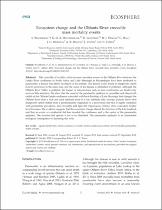JavaScript is disabled for your browser. Some features of this site may not work without it.
- ResearchSpace
- →
- Research Publications/Outputs
- →
- Journal Articles
- →
- View Item
| dc.contributor.author |
Woodborne, S

|
|
| dc.contributor.author |
Huchzermeyer, D

|
|
| dc.contributor.author |
Govender, D

|
|
| dc.contributor.author |
Pienaar, D

|
|
| dc.contributor.author |
Hall, G

|
|
| dc.contributor.author |
Myburgh, J

|
|
| dc.contributor.author |
Deacon, A

|
|
| dc.contributor.author |
Venter, J

|
|
| dc.contributor.author |
Lubcke, N

|
|
| dc.date.accessioned | 2012-10-30T09:53:34Z | |
| dc.date.available | 2012-10-30T09:53:34Z | |
| dc.date.issued | 2012-10 | |
| dc.identifier.citation | Huchzermeyer, S, Govender, D, Pienaar, D, Hall, G, Myburgh, J, Deacon, A, Venter, J and Lubcke, N. 2012. Ecosystem change and the Olifants River crocodile mass mortality events. Ecosphere, vol. 3(10),87. http://dx.doi.org/10.1890/ES12-00170.1 | en_US |
| dc.identifier.issn | 2212-0416 | |
| dc.identifier.uri | http://www.esajournals.org/doi/pdf/10.1890/ES12-00170.1 | |
| dc.identifier.uri | http://hdl.handle.net/10204/6247 | |
| dc.description | Copyright: 2012 Woodborne et al. This is an open-access article distributed under the terms of the Creative Commons Attribution License, which permits restricted use, distribution, and reproduction in any medium, provided the original author and sources are credited. | en_US |
| dc.description.abstract | Nile crocodile (Crocodilus niloticus) mass mortality events in the Olifants River between the Letaba River confluence in South Africa and Lake Massingir in Mozambique have been attributed to pansteatitis: a disease that affects fat depots of the animals. The disease is also found in sharptooth catfish (Clarias gariepinus) in the same area, and the cause of the disease is attributed to pollution. Although the Olifants River Valley is polluted, the impact of interventions such as dam construction on biodiversity receives little attention. We show that the onset of the pansteatitis epidemic in crocodiles and sharp tooth catfish at the Olifants/Letaba confluence coincided with back-flooding of Lake Massingir that changed the Olifants River from a rock and sand substrate river to a clay substrate lake. Isotopic analysis shows that sharptooth catfish shifted from a predominantly vegetarian to a piscivorous diet that is highly correlated with pansteatitis prevalence, and crocodiles and tiger fish (Hydrocynus vittatus) show coincident trophic level increases. The evidence suggests that the ecosystem change altered the structure of the lotic foodweb and that an exotic or extralimital fish has invaded the confluence and is the vector of the pansteatitis epidemic. The invasive fish species is yet to be identified. The pansteatitis epidemic is an unintended ecological consequence of damming this river. | en_US |
| dc.language.iso | en | en_US |
| dc.publisher | Ecological Society of America (ESA) | en_US |
| dc.relation.ispartofseries | Workflow;9742 | |
| dc.subject | Aquatic biodiversity | en_US |
| dc.subject | Clarias gariepinus | en_US |
| dc.subject | Crocodilus niloticus | en_US |
| dc.subject | Hydrocynus vittatus | en_US |
| dc.subject | Lotic foodwebs | en_US |
| dc.subject | Pansteatitis | en_US |
| dc.subject | Stable isotopes | en_US |
| dc.subject | Nile crocodile | en_US |
| dc.title | Ecosystem change and the Olifants River crocodile mass mortality events | en_US |
| dc.type | Article | en_US |
| dc.identifier.apacitation | Woodborne, S., Huchzermeyer, D., Govender, D., Pienaar, D., Hall, G., Myburgh, J., ... Lubcke, N. (2012). Ecosystem change and the Olifants River crocodile mass mortality events. http://hdl.handle.net/10204/6247 | en_ZA |
| dc.identifier.chicagocitation | Woodborne, S, D Huchzermeyer, D Govender, D Pienaar, G Hall, J Myburgh, A Deacon, J Venter, and N Lubcke "Ecosystem change and the Olifants River crocodile mass mortality events." (2012) http://hdl.handle.net/10204/6247 | en_ZA |
| dc.identifier.vancouvercitation | Woodborne S, Huchzermeyer D, Govender D, Pienaar D, Hall G, Myburgh J, et al. Ecosystem change and the Olifants River crocodile mass mortality events. 2012; http://hdl.handle.net/10204/6247. | en_ZA |
| dc.identifier.ris | TY - Article AU - Woodborne, S AU - Huchzermeyer, D AU - Govender, D AU - Pienaar, D AU - Hall, G AU - Myburgh, J AU - Deacon, A AU - Venter, J AU - Lubcke, N AB - Nile crocodile (Crocodilus niloticus) mass mortality events in the Olifants River between the Letaba River confluence in South Africa and Lake Massingir in Mozambique have been attributed to pansteatitis: a disease that affects fat depots of the animals. The disease is also found in sharptooth catfish (Clarias gariepinus) in the same area, and the cause of the disease is attributed to pollution. Although the Olifants River Valley is polluted, the impact of interventions such as dam construction on biodiversity receives little attention. We show that the onset of the pansteatitis epidemic in crocodiles and sharp tooth catfish at the Olifants/Letaba confluence coincided with back-flooding of Lake Massingir that changed the Olifants River from a rock and sand substrate river to a clay substrate lake. Isotopic analysis shows that sharptooth catfish shifted from a predominantly vegetarian to a piscivorous diet that is highly correlated with pansteatitis prevalence, and crocodiles and tiger fish (Hydrocynus vittatus) show coincident trophic level increases. The evidence suggests that the ecosystem change altered the structure of the lotic foodweb and that an exotic or extralimital fish has invaded the confluence and is the vector of the pansteatitis epidemic. The invasive fish species is yet to be identified. The pansteatitis epidemic is an unintended ecological consequence of damming this river. DA - 2012-10 DB - ResearchSpace DP - CSIR KW - Aquatic biodiversity KW - Clarias gariepinus KW - Crocodilus niloticus KW - Hydrocynus vittatus KW - Lotic foodwebs KW - Pansteatitis KW - Stable isotopes KW - Nile crocodile LK - https://researchspace.csir.co.za PY - 2012 SM - 2212-0416 T1 - Ecosystem change and the Olifants River crocodile mass mortality events TI - Ecosystem change and the Olifants River crocodile mass mortality events UR - http://hdl.handle.net/10204/6247 ER - | en_ZA |






